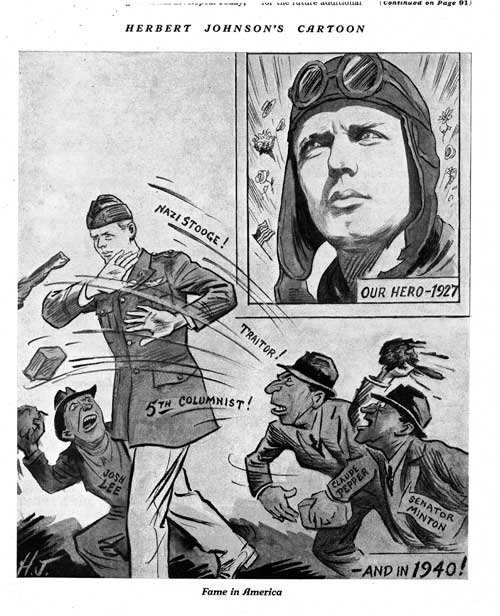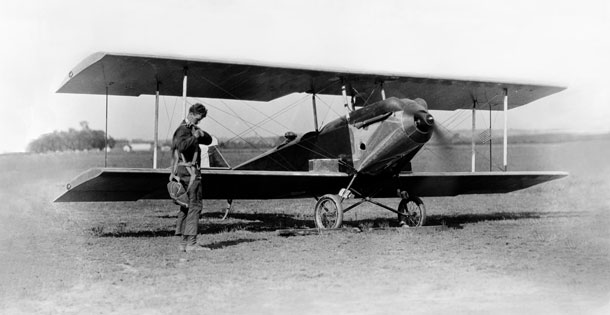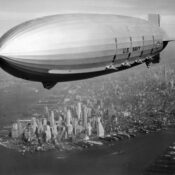
Having thus been banned from serving in the armed forces, Lindbergh talked to several old friends in the aircraft business about working for them as a civilian consultant for the development and testing of new bombers and fighters. Initially, the executives were enthusiastic — after all, Lindbergh had been involved in the design and production of aircraft since before his historic flight to Paris — but, one by one, they turned thumbs down on the idea. Juan Trippe, the head of Pan American Airways and an old friend of Lindbergh’s, told him that “obstacles had been put in the way.” The White House, Trippe explained, “was angry with him for even bringing up the subject” and told him it did not want Lindbergh “to be connected with Pan American in any capacity.” With billions of dollars in defense contracts at stake, no aircraft manufacturer could afford to offend the administration by taking Lindbergh on.
No one, that is, but Henry Ford. For years one of the most ardent isolationists in the country, Ford now presided over a thriving defense manufacturing empire, turning out engines, tanks, jeeps, staff cars, and aircraft, above all, B-24 bombers, which were built at Willow Run, Ford’s mile-long aircraft assembly plant outside Detroit. The government needed Ford as much as he needed the government’s business, and he made it clear he didn’t care what administration officials had to say about his hiring Lindbergh as a technical consultant.
For more than a year, Lindbergh worked to improve the design and performance of Ford-manufactured planes, including the B-24 and the P-47 fighter, known as the Thunderbolt. Making dozens of test flights, he operated the P-47 at extremely high altitudes to test the effect of such heights on both pilots and planes. As a result of his study, Ford modified the Thunderbolt’s design and oxygen equipment, which, according to the Air Forces, bettered the craft’s performance and helped save many pilots’ lives. Later in the conflict, Lindbergh worked as a consultant to United Aircraft Corporation, where he played a major role in the development and design of the Corsair, a new Navy and Marine fighter that could take off from aircraft carriers as well as from land bases.
Throughout the next three and a half years of war, Lindbergh belied the predictions of his critics that his goal was to topple the president. He resolutely stayed out of politics and the public eye, avoiding comment on the war’s progress and uttering no criticism of FDR and his policies. He had “purposely entered technical fields,” he told friends, so that he could give his “utmost support” to the country’s war effort and not be swept up again in political controversy.
Ever since his return from Europe in the spring of 1939, conventional wisdom had had it that Lindbergh would eventually run for public office. Each time the idea came up, however, Lindbergh rejected it. “I do not feel that I am suited, either by temperament or desire, to the field of active politics,” he wrote to Robert Wood in late 1941. Then, in a statement that is key to understanding him, he noted: “Personally, I prefer the adventure and freedom of going as far from the center as my thoughts, ideals, and convictions lead me. I do not like to be held back by the question of influencing the mass of people or by the desire for the utmost security. I must admit, and I have no apology to make for the fact, that I prefer adventure to security, freedom to popularity, and conviction to influence.”
While Lindbergh remained persona non grata in the upper reaches of the Roosevelt administration throughout the war, his military friends stayed loyal. In early 1944, some of them encouraged him to travel as a civilian consultant to the Pacific theater, where he could test fighters under combat conditions, show pilots how to get the best out of their aircraft, and make recommendations for design improvements. When he said the White House would never allow it, they replied, “Why does the White House have to know?”
A few weeks later, wearing a naval officer’s uniform without insignia, Lindbergh was on his way to the Pacific, without the knowledge of Roosevelt, [Secretary of the Navy] Frank Knox, or Henry Stimson. For the next five months, the 42-year-old civilian flew some 50 combat missions against the Japanese in Navy, Marine, and Air Forces planes while squadron leaders and higher-ranking officers looked the other way. During those missions, which included patrol, escort, strafing, and dive-bombing runs, he shot down at least one Japanese Zero and came close to being shot down himself.
As had been true back home, Lindbergh’s suggestions for changes improved the effectiveness of the planes he flew; in the case of the P-38 Lightning, his recommendations increased its range by 500 miles.
By all accounts, he was supremely happy during those perilous, exciting months. In photographs taken of him during that period, he almost always had a wide smile on his face. Flying with the military, [his wife] Anne wrote, “had made a new man of him — made him boyish again.” He developed close relationships with some of the young pilots with whom he flew, a number of whom were at least 20 years his junior. One morning, when he was a little slow retracting his landing gear while taking off on a mission, one of his youthful compatriots laughingly radioed him: “Lindbergh!…Get your wheels up! You ain’t flying the Spirit of St. Louis!”
After the war, even some of Lindbergh’s harshest critics acknowledged that he had acquitted himself well. Robert Sherwood, for one, conceded in his Pulitzer Prize-winning book Hopkins and Roosevelt that the man he had once denounced as a “Nazi” and “Hitler bootlicker” had in fact “rendered valuable wartime service as a civilian flyer.”
Less than a month before the end of the war in Europe, Franklin D. Roosevelt died of a cerebral hemorrhage in Warm Springs, Georgia. The president’s death, Lindbergh biographer A. Scott Berg noted, “did not affect Washington’s official attitude toward Lindbergh overnight. It took a week.”
In late April 1945, Charles Lindbergh officially emerged from political purdah. Summoned to Washington, he was asked to join a Navy-sponsored mission to Europe to study German developments in high-speed aircraft. With Roosevelt’s passing, he observed, “the vindictiveness in Washington practically disappeared as far as I was concerned.” He would later tell an interviewer that it was like the sun finally emerging from behind the clouds.
Throughout the late 1940s and into the 1950s, Lindbergh served as a special adviser to the U.S. Air Force (as the U.S. Army Air Forces was rechristened in 1947) and the Joint Chiefs of Staff, working on a multitude of projects, several of them focusing on rocketry, missiles, and the space program. As a consultant and director of Pan American Airways, he also made frequent business trips to Europe, Asia, and South America.
In 1954, President Dwight D. Eisenhower reinstated Lindbergh in the Air Force Reserve, with the rank of brigadier general. Eisenhower’s successor as president, John F. Kennedy, was another Lindbergh admirer. Kennedy had idolized the flier since childhood; an isolationist himself in college, he also had admired Lindbergh’s antiwar stand. In addition, he and Lindbergh shared a high literary distinction.
They both had been awarded the Pulitzer Prize for biography–Lindbergh in 1954 for Spirit of St. Louis, an autobiographical account of his flight to Paris, and Kennedy in 1957 for Profiles in Courage.
Yet for all the honors and feting of Lindbergh, he never was entirely able to put his problematic prewar past behind him. He told friends, for example, that he felt “very constrained” whenever he visited Britain. “Even after all these years,” said one Englishman who had met him, “he fears someone will attack him…over his behavior toward England in World War II.”
Unquestionably, Lindbergh himself was responsible for much of the controversy that arose in the postwar years over his isolationism. To the end of his life, he never admitted he was wrong about anything he had said or done. Unlike Anne, who acknowledged that “we were both very blind, especially in the beginning, to the worst evils of the Nazi system,” he uttered no word of remorse or apology for his uncritical attitude toward the horrors of Hitler’s regime. When his wartime journals were published in 1970, Lindbergh defiantly equated the Nazis’ wholesale murder of Jews with other war crimes, including the brutality of some American troops toward Japanese prisoners of war. He still insisted that the United States had made a mistake in entering the war.
“Like many civilized people in this country and abroad, he could not comprehend the radical evil of Nazism,” The New York Times wrote about Lindbergh and his journals. “Even in the retrospect of a quarter-century, he is unable to grasp it.…[T]here is simply no comparison between individual misdeeds of American soldiers toward dead or captured Japanese and the coldly planned, systematically executed German government policy of murdering or enslaving Jews, Slavs, and other ‘inferior’ people.…The world is admittedly not what Americans–or anyone else–would like, but it is decidedly better than it would have been if the United States had not helped to defeat German and Japanese militarism.…If any war can be said to be worth fighting and winning, it was World War II.”
As Lindbergh aged, he shed many of his previous interests, including his focus on modern technology, especially as it related to aviation. In 1928, when he had first begun courting Anne, he told her that his most cherished dream was to “break up the prejudices between nations by linking them up through aviation.” In later years, even though aircraft had indeed brought the peoples of the world closer together in a technical sense, “they have more than counteracted this accomplishment through their ruthless bombardments in war,” he would write. Both militarily and ecologically, he added, “I have seen the science I worshiped and the aircraft I loved destroying the civilization I expected them to serve.”
In the last decade of his life, he committed himself to the cause of halting man’s despoliation of nature, throwing himself into campaigns to save whales, water buffalo, eagles, and other endangered species. “If I had to choose,” he said shortly before he died, “I’d rather have birds than airplanes.”
Become a Saturday Evening Post member and enjoy unlimited access. Subscribe now




Comments
Charles Lindbergh, the flying hero,
Thought Hitler was invincible,
And would take all of Europe, so
The U.S. best should stay neutral.
Many a what if tale’s been told
If the U.S. stayed out of war.
Hitler was so crazy, but bold,
He’d have invaded U.S. shore.
Lindbergh’s last days were spent to save
Endangered species from man’s sport.
And no apology he gave
For giving Hitler such support.
It is one of those what if tales,
Would Hitler’s win have saved the whales?